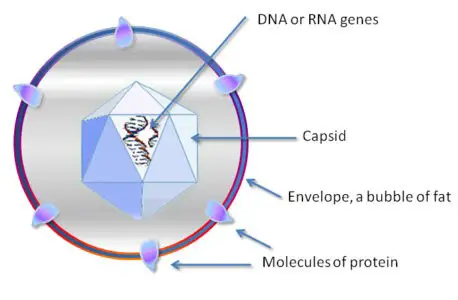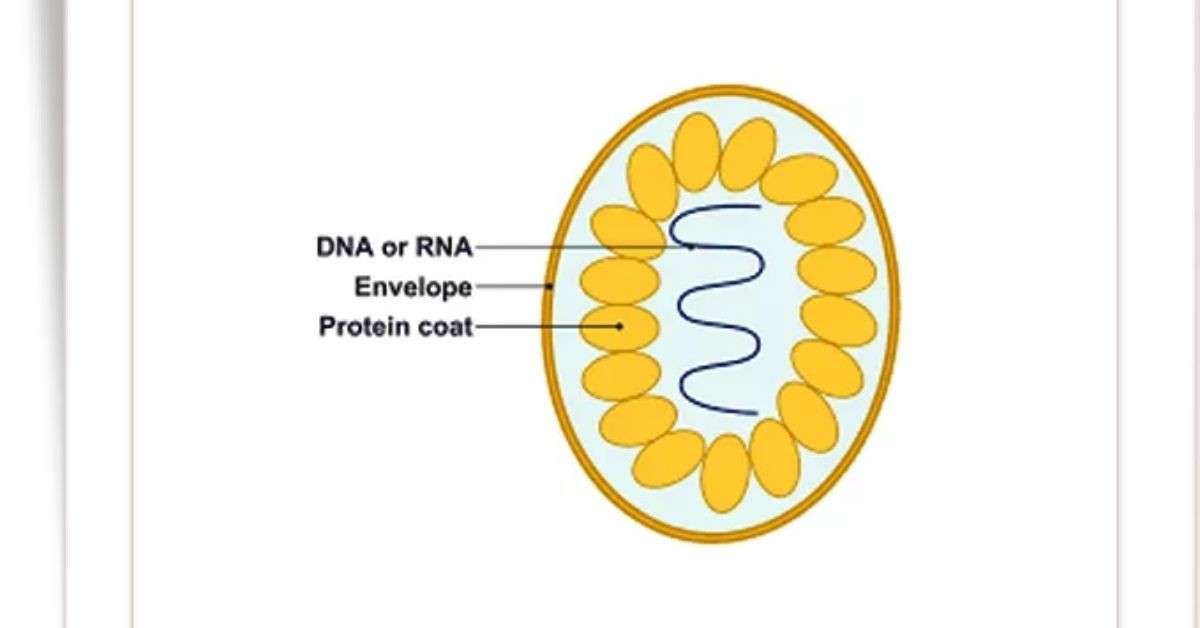A virus is an infectious biological agent of small size. The name ‘Virus’ comes from the Latin word meaning ‘poison’ or ‘slimy liquid’. The size of the viruses ranges from 20-300 nm. The chemical composition of all true viruses is nucleic acid either DNA or RNA and protein. They cannot multiply and continue the metabolic process without a host cell. About 5000 species of viruses have been identified. The shape of viruses varies from simple helical and icosahedral to more complex. They can cause diseases in man, plants and other animals.
External structure of Virus
Externally, the virus may be spherical, rod-shaped, cuboidal or tadpole-shaped.
Internal structure of Virus
Entire virus is called viron and consists of nucleic acid which is surrounded by a protective coat of protein called a capsid. An electron microscope shows that a virus particle is made up of two parts, an inner core of nucleic acid and the outer coat of protein. The nucleic acid component is either RNA or DNA, which lies centrally and surrounded by a membrane made up of protein.
The two main parts of the virus body are:
- Capsid or outer membrane
- Nucleoid- the parts lying within the capsid

Structure of Capsid: The protein coat of a virus particle is called the capsid. The membrane is composed of a number of identical subunits known as the capsomeres. The nucleic acid core and capsid together form the nucleocapsid. The number of capsomeres, their shape and component differ considerably in various kinds of viruses. The capsid of a virus is physiologically inactive. Capsid protects the nucleic acid from unfavorable conditions and helps the virus to penetrate within the body of the host cell. This part is left outside the host cell at the time of reproduction.
Each capsomere is composed of a few monomers and both of which are attached together by bonds. The virus particles in some cases on the outer side of the capsid are surrounded by means of an envelope. The envelope is composed of viral protein and lipid of the host cell.
In some virus such as Vaccinia virus, the capsid is composed of carbohydrate, fat, biotin, riboflavin and copper with 80% protein. The capsid of influenza virus possesses starch and fatty substances. Besides this, they possess numerous projected structure or spikes. The spikes are 10 nm long and situated 7.8 nm apart. In the Tobacco mosaic virus, the coat contains carbohydrate and other substances in addition to protein. Each virus capsid possesses a specific number of enzymes so that a virus can enter the host cell.
In some animal viruses, like Herpes virus, pox virus, the envelope situated outside the capsid and they are composed of viral protein and lipid which are derived from the host cell. The existence of lipids keeps the envelope loose and flexible.
The structural units of the envelope of the Lipoviruses are called pelpomeres. Pelpomeres are found in the viruses like Influenza virus, Herpes virus, Mumps virus, etc.
Structure of Nucleoid: The central core of the virus is composed of nucleic acid which is also called nucleoid. This part is covered by means of an outer coat of protein which is also called a capsid.
The nucleic acid is composed is Ribonucleic acid (RNA) and Deoxyribonucleic acid (DNA). Most of the plant viruses possess RNA but cauliflower Mosaic virus contains DNA while bacterial virus or Bacteriophase possesses DNA. On the other hand, Animal virus contains DNA (pox virus, herpes virus) or RNA (influenza virus, poliovirus).
Structure of Tobacco Mosaic Virus (TMV)

The virus responsible in causing disease of tobacco plants result in chlorosis of leaves and also alternate patches of yellow and green color in leaves giving mosaic appearance is called Tobacco Mosaic Virus (TMV).
Tobacco Mosaic Virus (TMV) was first isolated in the crystalline state from the sap of infected tobacco plants in 1935. In 1936, N.W. Pirie and F.C. Bawden found out the nucleoprotein nature of Tobacco Mosaic Virus. Studies by A.King and D.L.D. Casper showed the present of sub-units around the nucleic acid core. The structure of TMV was first observed by Takahasi and Rawlins.
Structure of TMV: Structurally TMV is very simple, with a helical hollow rod with approximately 300 nm length and 17 nm in diameter. TMV is composed of an outer protective protein coat and an inner core of single-stranded nucleic acid, RNA. The capsid is made up of capsomeres, arranged in a closely helical or spiral fashion along the entire length of the rod. The capsomeres are in turn composed of 158 amino acids arranged in definite sequence. Each nucleic acid, RNA core contains 400 units (nucleotides). In TMV, about 95% of the molecule is protein and 5% is a nucleic acid,
Contamination: Tobacco Mosaic Virus (TMV) is extremely infectious and stable. Inside the host cell separation of outer protein coat from nucleic acid take place. New particles formed from the host cell have the capability of causing infection again.
Structure of Bacteriophase (T2 virus)

Generally, the bacterial virus is called bacteriophage or T2 virus. The term bacteriophage was given by Felix d`Herelle in 1917. The bacteriophage was first successfully isolated by M. Schlesinger in 1933.
The bacteriophage is composed of DNA and protein. DNA consists of one continuous molecule which is about 50 µm long, tightly condensed in the shape head and enveloped with a layer of protein. They have a tadpole shape with hexagonal heads and a long tail.
Body Parts
The body of bacteriophage consists of :
- Head
- Neck
- Tail and
- Base plate
Head: The head is 6 faced with two protein layers. Inside the hollow cavity of the head lies the double-stranded DNA. The capsid of the head is formed of several capsomeres. Capsid generally possesses a cuboidal symmetry.
Neck: The neck is a tube-like structure which connects with the head and the tail portion. It is surrounded by a circular disc, the collar at the mid part. The posterior end of the neck is projected into the front hole of the tail core.
Tail: It is a tube-like portion which consists of two parts, the inner hollow core and the surrounding outer protein sheath called the tail sheath.
Base plate: The tail end in a base plate bears long slender thread-like tail fibers which help in anchoring the virus to the host cell. The base plate has a pin or spike attached to its lower surface at each corner. The appropriate length and width of a bacteriophage are 200-265 µm and 50-70µm respectively.

